how to find the correlation coefficient in excel
3 Ways to Calculate a Pearson'southward Correlation Coefficient in Excel
If you've ever learnt some statistics, then you've probably come across the correlation coefficient.
Only tin can y'all calculate this in Excel?
Aye, you tin!
Excel tin exist a great tool for a statistician when you know how to use it.
In this post, I'll show you three ways to summate the correlation coefficient in Excel.
Video Tutorial
What is a Correlation Coeffecient?
The correlation coefficient is as well known as the Pearson Correlation Coefficient and it is a measurement of how related two variables are.
The calculation tin can have a value between 0 and 1.
A value of 0 indicates the ii variables are highly unrelated and a value of 1 indicates they are highly related.
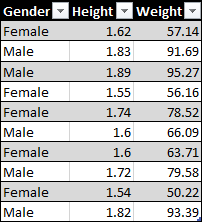
For example, you might accept data on pinnacle (meters) and weight (kilograms) for a sample of people and desire to know if these ii variables are related.
Intuitively, you would think a person's height and weight are related, just the correlation coefficient will show you mathematically how related or unrelated these are.
Correlation Coefficient Formula

The correlation coefficient r can be calculated with the above formula where x and y are the variables which yous desire to examination for correlation.
In this example, the ten variable is the height and the y variable is the weight. r is then the correlation between height and weight.
Computing the Correlation Coefficient from the Definition
Let's see how we can calculate this in Excel based on the above definition.
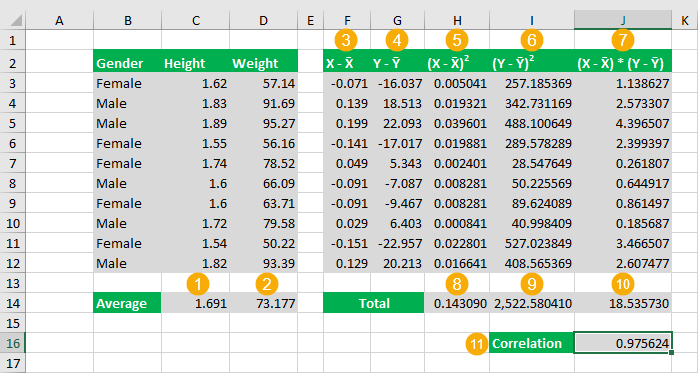
There are quite a few steps involved to calculate the correlation coefficient from scratch.
- Calculate the boilerplate tiptop.
= Average ( C3:C12 ) - Summate the average weight.
= AVERAGE ( D3:D12 ) - Calculate the deviation between the summit and average height for each information betoken. This formula will demand to be copied downward for each row.
= C3 - $C$14 - Summate the difference between the weight and average weight for each data betoken. This formula volition need to be copied down for each row.
= D3 - $D$14 - Calculate the square of the departure from step 3 for each row.
= Ability ( F3, ii ) - Calculate the foursquare of the difference from step 4 for each row.
= Power ( G3, two ) - Calculate the product of differences from step 3 and 4 for each row.
= F3 * G3 - Calculate the sum of the squared differences from footstep 5.
= SUM ( H3:H12 ) - Calculate the sum of the squared differences from footstep 6.
= SUM ( I3:I12 ) - Calculate the sum of the product of differences from stride 7.
= SUM ( J3:J12 ) - Calculate the correlation with the following formula.
= J14 / ( SQRT ( H14 ) * SQRT ( I14 ) )
It's quite an involved calculation with a lot of intermediate steps.
Thankfully Excel has a built in function for getting the correlation which makes the adding much more elementary.
CORREL Role
This is a part specifically for calculating the Pearson correlation coefficient in Excel.
It's very easy to apply. Information technology takes two ranges of values equally the only two arguments.
= CORREL ( Variable1, Variable2 ) - Variable1 and Variable2 are the 2 variables which y'all want to summate the Pearson Correlation Coefficient between.
- These are required inputs and must be a single column or unmarried row array of numbers. Variable1 and Variable2 must besides have the aforementioned dimension.
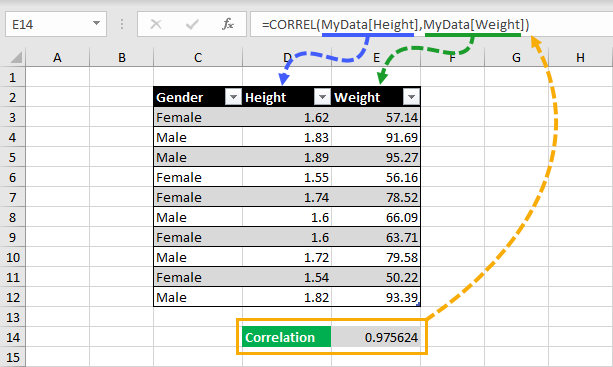
= CORREL ( Meridian, Weight ) The higher up formula is what you lot would need to summate the correlation betwixt height and weight.
Wow, so much easier than computing it from scratch!
This method is also dynamic. If your information changes, the correlation calculation will update to reverberate the new data.
Statistical Tools
Excel comes with a powerful statistical tools add-in, only you demand to enable it to use it first and it's quite subconscious.

To enable the Analysis ToolPak:
- Go to the File tab and and so choose Options.
- Go to the Add-ins tab in the Excel Options.
- Choose Excel Add together-ins from the drop-down list and printing the Become push.
- Check the Analysis ToolPak pick from the available add-ins.
- Press the OK button.

You will now have a Data Analysis command available in the Information tab and you can click on this to open the Analysis ToolPak.
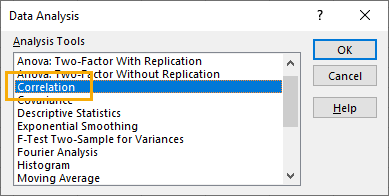
This volition open up the Data Analysis carte du jour and you can then select Correlation from the options and printing the OK button.
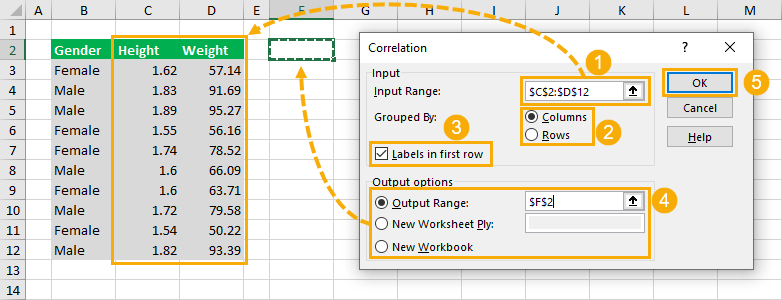
This will open up the Data Analysis Correlation menu.
- Supply the Input Range for the correlation calculation. This should be a range with numerical values organized into columns or rows.
- Select the Grouping By selection of Columns or Rows. This example has the data organized past columns as values for height are all in one column and values for weight are in a dissever column.
- Select whether or not your input range has Labels in the first row. These labels are used later in the output so it'south best to select an input range that includes the labels.
- Select where to place the output in the Output options. You can choose from a location in the electric current sheet, a location in a new sheet, or a new workbook.
- Press the OK push create the adding.
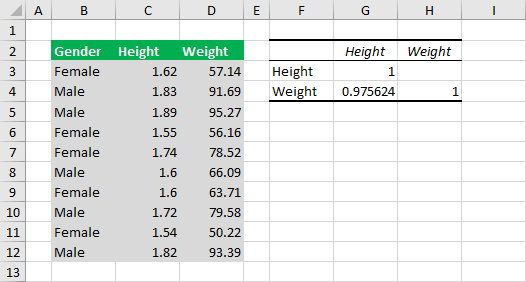
This volition output a correlation matrix.
This ways if you have more two columns of variable, the matrix volition contain the correlation coefficient for all combinations of variables.
The drawback of this method is the output is static. If your data changes, you lot volition need to rerun the information analysis to update the correlation matrix.
Conclusions
Correlation is a very useful statistic to determine if your data is related.
The mathematical formula can be intimidating though, particularly when trying to calculate it in Excel.
Thankfully there are a few easy means to implement this calculation in Excel.
About the Writer
![]()
John is a Microsoft MVP and qualified actuary with over 15 years of experience. He has worked in a multifariousness of industries, including insurance, ad tech, and well-nigh recently Power Platform consulting. He is a peachy problem solver and has a passion for using technology to make businesses more efficient.
Source: https://www.howtoexcel.org/correlation-coefficient/
Posted by: davisinscurs36.blogspot.com

0 Response to "how to find the correlation coefficient in excel"
Post a Comment